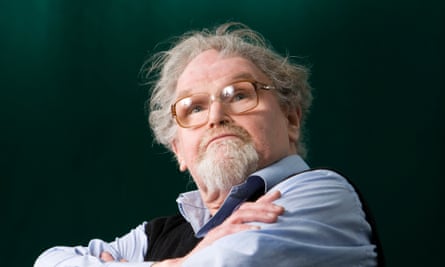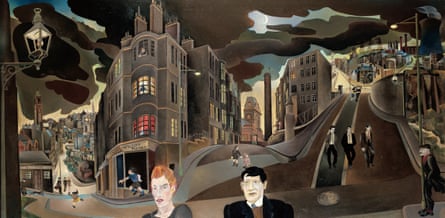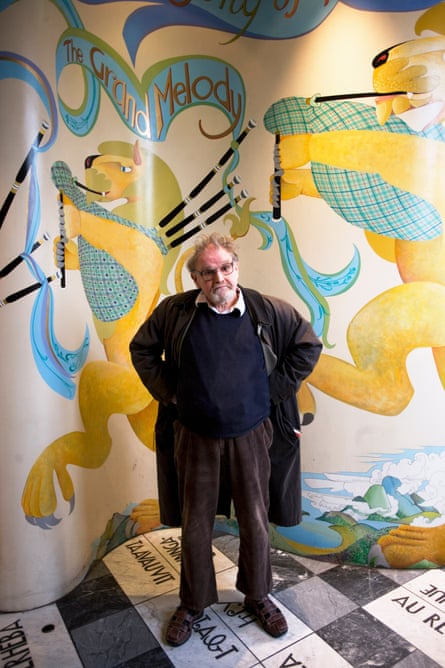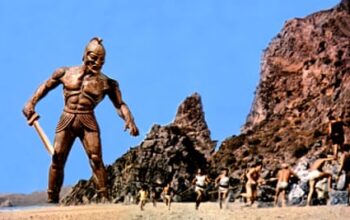A
Lasdair Gray was a notable figure in Scotland, known for his unique talents. He was an artist and writer from Glasgow, and his work often portrayed his hometown through a mix of fantasy and gritty realism. His paintings captured the essence of city life in intricate detail.
He authored Lanark, which is considered to be one of the most renowned British novels of the 20th century. He also decorated various bars, restaurants, and stations in the city with his unique murals. His work has influenced a new generation of Scottish writers such as Iain Banks and Irvine Welsh.
“He was a contemporary William Blake,” claims writer Ali Smith. According to Sorcha Dallas, who oversees the Alasdair Gray Archive, “Alasdair is the Glasgow equivalent of Charles Dickens in London or James Joyce in Dublin.”
Unfortunately, Gray’s talents were not fully recognized beyond Scotland even after his passing in 2019. His unique perspective and style were deeply rooted in Scottish culture. However, there is potential for a change as it was announced that one of his works will be adapted into a major film in 2024. Poor Things, which earned Gray the Whitbread award and the Guardian fiction prize in 1992, will be directed by Yorgos Lanthimos, who has already received three Academy Award nominations for his previous films The Lobster and The Favourite.

The credentials of the latter are promising because Poor Things is an extremely demanding novel: a Victorian, feminist interpretation of Frankenstein that also features satirical references to 19th-century literature, colonialism, and medical ethics. Additionally, Gray’s tale of Bella Baxter and her revival is closely connected to real locations. Bella’s residence is listed as 18 Park Circus, an actual city address, and the Lansdowne church, where she gets married, is also a real location. Maps and illustrations of Glasgow, many of which were drawn by Gray himself, are included in the book to assist readers in following his imaginative storyline. Poor Things exudes the essence of Glasgow.
However, the movie did not undergo the same change. When it premiered at the London film festival in October, it was evident that Lanthimos had removed any references to the city and replaced it with a peculiar, steampunk version of London as the primary setting. For some viewers, it may feel like watching The Lord of the Rings without Middle Earth or Titanic without the iceberg.
Gavin Lundy, from the YouTube channel Ossian Scotland, emphasizes this point in his video titled “The Poor Things Problem.” He states that the book is a distinct representation of Glasgow and Scotland, but the issue is that it was not filmed or acted out by any Scottish individuals.

Lanthimos explains that it would have been insincere for him, being Greek, to create a film about Scotland. Producers Ed Guiney and Andrew Lowe also mention that their choice to focus solely on Bella Baxter’s perspective, portrayed by Emma Stone, required some changes, such as exchanging Glasgow for London. However, they assure that Willem Dafoe’s character, Godwin Baxter, will still be a scientist from Glasgow. The adaptation stays faithful to the essence of Alasdair’s work.
The outcome is a captivating and exciting cinematic masterpiece, which received the prestigious Golden Lion award at the Venice film festival. Stone’s portrayal of Bella has raised her chances of winning an Oscar in March, with Peter Bradshaw of the Guardian praising her “amazing and humorous performance”.
The reaction of audiences when the film is released in British cinemas on January 12 is uncertain, but it is likely that Glasgow and Gray will remain as supporting attractions. The city’s only claim to fame in the cinematic world is its frequent use as a budget-friendly substitute for American towns with similar architectural styles and street layouts. It has stood in for Philadelphia in World War Z, New York in the latest Indiana Jones film, and San Francisco in Cloud Atlas. However, it has not made much of an impact on its own, with the exception of the sci-fi thriller Under the Skin, which stars Scarlett Johansson.
Glasgow continues to be a mystery in terms of its artistic representation, as Gray himself emphasized. In Lanark, a character states, “Glasgow is a stunning city.” However, it is often overlooked because people don’t envision living there. Cities like Florence, Paris, London, and New York are familiar to visitors because they have been depicted in various forms of art, literature, and media. But if a city has not been captured by an artist, even the residents do not imagine it creatively.
Gray started to rectify this exclusion by creating books and paintings, establishing Glasgow as a noteworthy location on the global literary and artistic scene. While the film adaptation of Poor Things may have hindered this progress, Rodge Glass, Gray’s biographer, believes it will soon be back on course. Glass states, “Even if only a small percentage of viewers of Poor Things end up reading the book, it will introduce thousands of people to Glasgow and Gray, who may have had limited knowledge about them before. This can only have positive effects.”

Dallas explains that visitors can catch a glimpse of Gray’s impressive work and his ties to his hometown by visiting his archive. Located in a former whisky storage building along the Forth and Clyde canal, the main room displays the desk and chair where Gray created his written and artistic pieces. These items were originally in his small flat in Hillhead, where he resided and worked in a state of financial struggle.
He prioritized his art over money and would often create murals at different establishments in exchange for food and drinks. On occasions when he did have money, he would often give it away. Gray also used a significant amount of money he received as a literary award to support striking miners and assisted emerging Scottish writers in getting their work published.
Dispersed throughout the room are various items that offer a glimpse into the life of Gray. He humorously described himself as a “chubby, bespectacled, balding, elderly man from Glasgow who has primarily made a living through writing and designing books, mostly fiction.” Among the items are a correction slip inserted into copies of his book Unlikely Stories, Mostly, which simply states “This slip was mistakenly placed here.” Stacks of his books are neatly arranged next to his preferred dishes, while shelves display his paintings, drawings, and typographical experiments, along with numerous other personalized trinkets.
For those interested in tracing the true origins of his work in Glasgow, the archive has created the Poor Things Trail. It starts at Lansdowne parish church on Great Western Road, where Bella’s wedding was interrupted on Christmas Day 1883. The church now serves as a theater, where staff expressed disapproval during a conversation about removing Glasgow and Gray from the film. One person exclaimed, “That’s ridiculous!”
Continuing down the path, tourists arrive at Park Circus, where opulent townhouses overlook the West End of the city. This is where Bella first had a place to call home. Moving further west, the trail leads to Byres Road, home to the Ubiquitous Chip restaurant, the bar and performance venue Óran Mór, and the Hillhead underground station, all of which showcase Gray’s murals. According to Monica Callaghan, a trustee of the archive at Glasgow University, “Alasdair’s presence is deeply rooted in the physical structures of this city.”
Glass is positive about the potential impact of the film’s release on Gray’s reputation. He points out that there have been approximately 30 adaptations of Alice in Wonderland since the first silent film version, demonstrating that no film can claim to be the definitive version. With its focus on conflicting storytelling, Poor Things lends itself to multiple film interpretations. Glass suggests that there may even be a Scottish version made in the future if someone becomes passionate enough about it.
20 years ago, there were plans to shoot Poor Things in Scotland, but the endeavor was unsuccessful. Glass suggests that it may be worth considering why the film was not originally made in this location.
Source: theguardian.com


